In the 1970s and early ’80s, Goldfinger and Dove often visited the famous magician Channing Pollock at his Moss Beach home–as well as at the “Worm Farm” in San Gregorio. Where are they today?
_qacct=”p-d4LE6XcfPbfZY”;quantserve();

Created by June Morrall
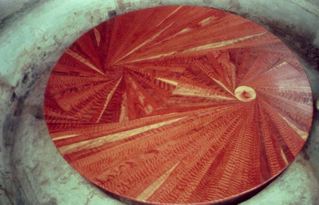
Photo: Table designed/built by John Morrall
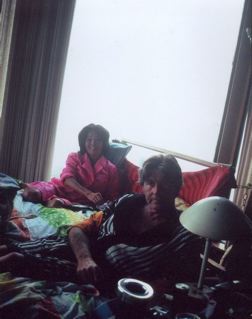 Photo: Corri & Channing.
Photo: Corri & Channing.
The magician Channing Pollock and his artist wife, Corri, had this beautiful, round table designed for their unusual Moss Beach house. The table was in their bedroom, with views of the Pacific Ocean, a place where they most often entertained their many friends. The table was set into a “pit” at floor level. The seating around the table was covered with the wall-to-wall rug.
According to Miramar Beach kayak enthusiast and photographer, Michael Powers, most of the Coastsiders “were curious and interested” about Babaji’s visit to the farm at San Gregorio.
What he captured on film were “a lot of kids and ‘flower children’ running all over the place. Fresh fruit and blossoms were placed at the master’s feet,” said Powers. “It was theatrical and wonderfully staged. There was a genuine feeling of generosity, of spirituality.”
One Coastside source–who recounted her experience on the condition that I not use her name–said she wore a leaf green tunic with rust-orange stripes and white muslin pants. “I wanted to wear something loose and comfortable,” she told me. “I had seen many photos of the Beatles and the Maharaja and I based my outfit on that image.”
Then a resident of San Gregorio, this source also recalled meeting Babaji as he ascended the hill.
“I was introduced to him,” she recalled. “The white robes told me he was someone to be revered. I wondered if it was good luck to shake his hand. It put me in a good mood.”
When Babi Hari Dass arrived, he was accompanied by some 50 of his followers from Santa Cruz, all of them wearing white and ecru gauzy fabrics. Some of them held strands of sandalwood beads. Michael Powers noted that the followers tended to be “fanatic and committed.”
With a peaceful smile on his face, Babaji sat cross-legged on the Indian rug beneath an orange parachute. All eyes turned to watch the tanned and barefooted young woman in the green and white sarong drop a fresh bouquet of wildflowers at the master’s feet.
…To be continued…
Note: I have misplaced a lovely color photo of Babaji taken at the San Gregorio Farms event.I’ll post it when I find it–the photo really helps define the story.
The Astanga Yoga that he practiced also embraced meditation, posture discipline as well as a vegetarian diet. Santa Cruz resident Peggy Bazarnick, an ardent follower for 15 years, told me in 1993 that Babji “stresses the right way of living. That means not harming anyone, caring for the body, while not being attached to the body.”
Peggy added that during private interviews “he never tells anyone what to do. He knows everything; he looks right through you and knows all. He will offer you options but he will never tell you what you should do.”
In 1971 the Hunuman Foundation, a California group, made the arrangements which brought Babi Hari Dass from India to Santa Cruz where he settled.
Not everyone in the tiny village of San Gregorio was pleased about the coming of the spiritual teacher.
“Dick the Gardener”, the tall, reclusive, awkward young man who lived on the worm farm, grumbled bitterly when the lower field was plowed for the festivities. A Cornell University graduate, he dropped out of the academic scene to pursue an alternative lifestyle.
“Dick the Gardener” leased a patch of land became locally renown for the quality of the organic tomatoes, squash and garlic that prospered under his care.
He was cynical about the event; he felt certain that the outsiders would trample and destory his precious new tomato crop.
…To be Continued…
In June of 1975, Babi Hari Dass, a spiritual teacher from India visited the Coastside. His appearance was later called “a visual spectacle, comparable to a scene from the movie, ‘Ghandi'”.
The “happening” took place in the lower field of what the locals called “the worm farm” at San Gregorio.
The “worm farmers” (who had traded the glitz of Los Angeles/Beverly Hills for the Coastside’s rustic serenity) were raising earthworms commercially in long, narrow, custom-built redwood planters in a small corner of the several hundred-acre ranch.
Not far from where the earthworms were burrowing in their special soil mixture in a scooped-out section of earth beside a creek, someone had unfurled a bright orange parachute. The colorful covering was protection for the 100 expected guests–a contrast of locals and devoted followers of Babi Hari Dass. They would sit on bales of hay or on pretty Oriental carpets that had been placed on the ground.
A statute of the goddess Kwan Yin, with one palm extended and open, the joined forefinger and thumb forming a circle on the other hand, conveyed a peaceful spirit among the pots of pink and white Sweet Williams.
Special care was taken by all to avoid treading on the large Indian rug, centrally located and reserved for the 51-year-old spiritual guest of honor.
Along with other Coastsiders, I was invited to meet and ask questions of “Babaji” (a term of respect). He was a short, kind-faced, bearded man wearing a long white robe. What was most unusual was that as a practitioner of Astanga Yoga, he had not spoken a word to anyone for 25 years.
“Babaji” communicated by writing on the little chalkboard strung around his neck–or when more words were necessary, he used the larger, portable chalkboard strung around his neck–or when even more words were necessary, he used the large, portable chalkboard that he carried with him.
…to be continued…
…and its main crop, the agricultural earthworm 
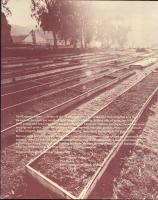 The bins were filled with the hybrid earthworms (and soil, of course)
The bins were filled with the hybrid earthworms (and soil, of course)
Photos: Below: Pouring cement for a new floor in one of the farm’s barns. 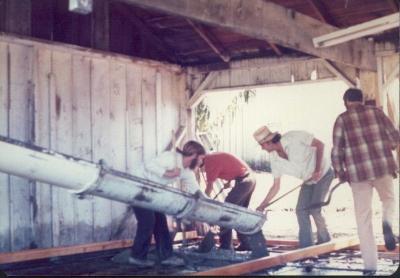
Center: 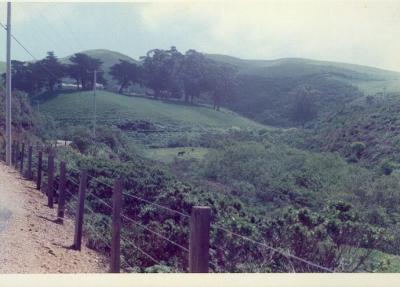 Beautiful view of the San Gregorio Ranch in the 1970s, today part of POST (Peninsula Open Space Trust).
Beautiful view of the San Gregorio Ranch in the 1970s, today part of POST (Peninsula Open Space Trust).
At San Gregorio Farms, in the 1970s, the main crops weren’t artichokes or chocolate milk cows.
What do you think it was?
I’ll give you one guess…..Nope.
How about a super-agricultural earthworm, a hybrid called “the small miracle”?
The 300-acre ranch at San Gregorio had its quota of conventional farm animals: chickens, ducks, horses, cows, pigs and ponies but the 1970s was the decade of “everything to do with gardening”–organic compost, crocheted potted plant hangers, ferns, ferns, ferns–and so the earthworm, long neglected as a soil enchancing creature, slithered to its very brief moment of glory.
I knew the owners, Channing and Corri Pollock, because my Ex, a talented contractor, turned their woodworking concepts into reality. The Pollocks visited their ranch often, spending days and evenings there–but actually lived in a unusual home overlooking the sea in Moss Beach.
They were an extraordinary couple. He had been a tuxedo-ed magician whose magical spells made his white doves vanish on the wildly popular Ed Sullivan Show in the 1950s and she was a beautiful, artistic and wealthy woman. Now retired, they were drawn to the soil.
“We want you to meet a small miracle,” the San Gregorio Farms pamphlet explained.
“Our most fascinating work is with our domesticated earthworms…and related soil improvement research. We cultivate on a large commercial basis a rugged hybrid species of earthworm uniquely suited to gardening, orchard and farming methnods….”
These hearty creatures were not like fleas performing tricks at the circus; they were hard workers.
In order to get the word out as to how valuable these critters were, the Pollocks signed up for a large display booth at the legendary rock impressario Bill Graham’s “World of Plants” exhibition held at the Cow Palace.
Channing recognized the theatrical possibilities.
The entire event had to be choreographed. Corri designed the brown costumes, even the shoes (see photo of Roland Reese pointing to a custom-made container.) for the booth attendants who answered the public’s questions with the hope of selling worms. The Pollocks intended to spend full time at the trade show and to be comfortable they brought exquisite furniture from their Moss Beach living room. Oriental rug. Coffee table. Couch.
Constructing the display booth turned into a monumental task because the Pollocks required the booth to be hand-carved, using only the earthworm as the motif. Throughout the space, the earthworm was the dominant theme.
Even the redwood containers, home to the earthworms, were custom-made, including one in the photo that looks like a pyramid. The budget buyer carried his or her earthworms home in a clever simulation of a Chinese take-out box.
During the final inspection of the booth, the Pollocks, to their horror, noted the main wall of the booth was blank. Emergency! It needed something quick. A mural?
How about a life-size photo of a pair of beautiful young people holding the reins of super earthworms a they till the soil.
Mark and Flower looked just great–they were a gorgeous couple often asked to model. Michael Powers, the Miramar Beach photographer, took pictures of them in the flower fields of Half Moon Bay or riding on the white sandy beaches. But they’d never shared the camera with earthworms before. (See photo of Mark and Flower below).
San Gregorio Farms was the talk of the Bill Graham “World of Plants” exhibition but the hybrid earthworms never were launched as a business. Everything the Pollocks did they did with style and grace–and the earthworm caper was no exception.
Note: Channing Pollock passed away at age 79 in Las Vegas on Sunday, March 19. His wife, Corri died a few years ago in Moss Beach.
(All photos–June)